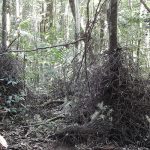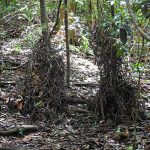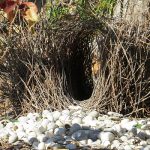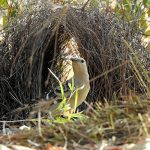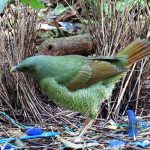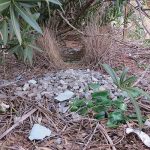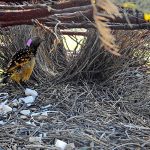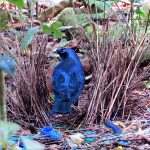BOWERS
The Marvel of Bowerbird Architecture
In the woodlands and forests of Australia, a unique and dazzling courtship ritual unfolds every breeding season. The architects behind this natural spectacle are the bowerbirds — renowned not for their singing, but for their spectacularly decorated structures called bowers. These constructions are not nests for raising chicks, but arenas of romance built to attract and impress potential mates.
What Is a Bower?
A bower is a carefully constructed and skilfully decorated structure made by male bowerbirds. It serves as both a stage for intricate courtship dances and a gallery for a vibrant array of collected treasures.
Two Main Types of Bowers
| Type | Description | Example Species |
|---|---|---|
| Avenue Bower | Two parallel walls of sticks forming an avenue or alley. | Satin Bowerbird |
| Maypole Bower | Upright sticks often built around a central sapling, creating a teepee-like structure. | Golden Bowerbird |
How Are Bowers Built?
Picture a male bowerbird meticulously gathering hundreds, sometimes thousands, of twigs and carefully arranging them into a shelter. It is a process that can take weeks and demands extraordinary patience.
- Step 1: Select a site, often on the forest floor, sheltered by foliage.
- Step 2: Gather sticks, twigs, and grass stems to build the main frame.
- Step 3: Decorate: the true artistry begins with the addition of brightly coloured objects.
- Blue is especially favoured by the Satin Bowerbird, who may use feathers, berries, plastic, or even pen caps.
- Green & white coloured objects is especially favoured by the Great & Spotted Bowerbirds.
- Some species use shells, stones, leaves, or even bits of glass.
Why Do Bowerbirds Build Bowers?
The function of the bower is simple but crucial: attract a mate. Females arrive to inspect the bowers and judge the quality of both the construction and decorations. The male may perform an elaborate dance, displaying his treasures.
Females choose their partners based largely on the appeal of the bower, making these displays a powerful example of sexual selection in the animal kingdom.
The wonders of bowerbird architecture offer a vivid reminder that animal behaviour is as diverse and specialised as the habitats these birds depend on. As Australian landscapes change, it becomes increasingly important to protect the forests and woodlands where bowerbirds express their remarkable creativity.
By understanding and valuing these natural builders, we are inspired to preserve the environments that make such marvels possible.
The next time you find a forgotten blue bottle cap on a forest path, consider the possibility that it might soon become a treasure in the artistic world of a bowerbird. Their intricate structures remind us of the creativity alive in the animal kingdom and our shared responsibility to protect these wonders for generations to come.

